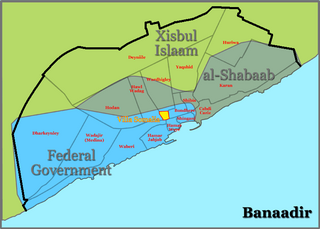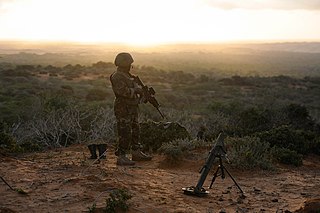
Beledweyne is a city in central Somalia. Beledweyne District is the capital city of the Hiran region.

The Ethiopian occupation of Somalia, also called the Ethiopian invasion of Somalia or the Ethiopian intervention in the Somali Civil War, was an armed conflict in Somalia that lasted from 2006 to 2009. It began when military forces from Ethiopia, supported by the United States, invaded Somalia to depose the Islamic Courts Union (ICU) and install the Transitional Federal Government (TFG). The conflict continued after the invasion when an anti-Ethiopian insurgency emerged and rapidly escalated. During 2007 and 2008, the insurgency recaptured the majority of territory lost by the ICU. At the start of 2009 Ethiopian troops withdrew from Somalia, but became re-involved several years later to counter the growing strength of Al-Shabaab.

The 2006 Islamic Courts Union offensive is the period in the Somali Civil War that began in May 2006 with the Islamic Courts Union's (ICU) conquest of Mogadishu from the Alliance for the Restoration of Peace and Counter-Terrorism (ARPCT) and continued with further ICU expansion in the country. Following the outbreak of the war on December 21, 2006; by December 24, direct Ethiopian intervention in the conflict in support of the Transitional Federal Government (TFG) was no longer denied by the Ethiopian government. The Eritrean government denied any involvement despite Ethiopian claims to the contrary.
The timeline of events in the War in Somalia during 2006 is set out below.

The timeline of events in the War in Somalia during 2007 is set out below.
The 2008 Battle of Mogadishu began when Ethiopian soldiers started entering insurgent-held parts of the city which sparked heavy street fighting. Between 126 and 142 people died in the fighting. The battle usually includes the date, when referenced, in order to distinguish it amongst the nine major Battles of Mogadishu during the decades long Somali Civil War.

The siege of Baidoa was a military confrontation lasting from July 2008 to January 2009, in which the al-Shabaab militia laid siege to the headquarters of the Somali Transitional Federal Government (TFG).
The Battle of Kismayo began on August 20, 2008 when Ogaden clan fighters took the battle to Ethiopian forces in Kismayo and their protectorate clan, the Marehan clan. Fighters began an offensive to conquer the Southern Somali port of Kismayo from pro-government militias. Three days of fighting reportedly killed 89 people and injured 207 more. The Ogaden clan led by Ahmed Madoobe took the town, at the expense of the Marehan clan who were up to that point kept in the city by the Ethiopian army. After the retreat of the Ethiopian army, the Marehan militia led by Barre Hiiraale were seen fleeing the city in all directions before eventually succumbing to Ras Kaambooni on August 22.

The 2009 timeline of events in the Somalia War (2006–2009) during January 2009 is set out below. From the beginning of February the timeline of events in the Somali Civil War (2009–present) is set out following the conclusion of the previous phase of the civil war.

The Somali Civil War (2009–present) is the ongoing phase of the Somali Civil War which is concentrated in southern and central Somalia. It began in late January 2009 with the present conflict mainly between the forces of the Federal Government of Somalia assisted by African Union peacekeeping troops and al-Qaeda aligned al-Shabaab militants.

A series of battles in Hiraan, Shabeellaha Dhexe and Galgudug, between rebels of al-Shabaab and Hizbul Islam and Somali government forces and ICU militants loyal to the government, erupted during spring 2009. The fighting led to al-Shabaab capturing major government strongholds and Ethiopian forces re-entering Somalia and setting up bases in Hiraan. There was a halt in fighting during a government offensive in Mogadishu, which started on May 22.
The January 2010 Battle of Beledweyne began on January 10, 2010 when Ahlu Sunna Waljama'a forces attacked and captured East Beledweyne which was being held by the Hizbul Islam insurgent group. It was initially reported that TFG forces took part in the offensive however Ahlu Sunna Waljma'a leaders said the government was not helping them during the offensive. Fighting soon spread from the East to the center of the city. It became the first battle in months were al-Shabaab and Hizbul Islam groups cooperated against the TFG.

The Battle of Mogadishu (2010–11) began on 23 August 2010 when al-Shabaab insurgents began attacking government and African Union Mission to Somalia (AMISOM) positions in the Somali capital of Mogadishu. Al-Shabaab began its offensive after its spokesman said the group was declaring a "massive war" on troops sent by AMISOM, describing its 6,000 peacekeepers as "invaders". In December 2010 the number of AMISOM troops was increased to 8,000 and later to 9,000. The battle's name usually includes the years, when referenced, in order to distinguish it amongst the nine major Battles of Mogadishu during the decades long Somali Civil War.

This is a 2011 timeline of events in the Somali Civil War (2009–present).

This is a 2012 timeline of events in the Somali Civil War (2009–present).

This is a 2014 timeline of events in the Somali Civil War (2009–present).

Operation Indian Ocean was a joint military operation between the Somali military, AMISOM and the United States military against the Al-Shabaab militant group aimed at eliminating the remaining insurgent-held areas in southern Somalia. It officially began in August 2014.
This article contains a timeline of events for the Somali jihadist group al-Shabaab.

This is a 2013 timeline of events in the Somali Civil War (2009–present).

This is a 2010 timeline of events in the Somali Civil War (2009–present).












